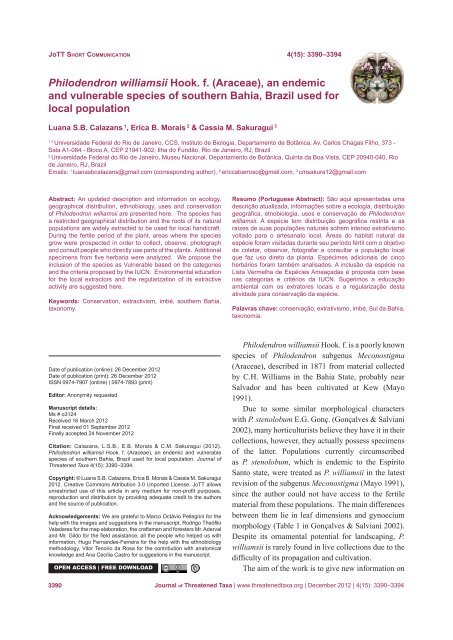December 2012 - Journal of Threatened Taxa
December 2012 - Journal of Threatened Taxa
December 2012 - Journal of Threatened Taxa
You also want an ePaper? Increase the reach of your titles
YUMPU automatically turns print PDFs into web optimized ePapers that Google loves.
JoTT Sh o r t Co m m u n ic a t i o n 4(15): 3390–3394<br />
Philodendron williamsii Hook. f. (Araceae), an endemic<br />
and vulnerable species <strong>of</strong> southern Bahia, Brazil used for<br />
local population<br />
Luana S.B. Calazans 1 , Erica B. Morais 2 & Cassia M. Sakuragui 3<br />
1,3<br />
Universidade Federal do Rio de Janeiro, CCS, Instituto de Biologia, Departamento de Botânica, Av. Carlos Chagas Filho, 373 -<br />
Sala A1-084 - Bloco A, CEP 21941-902, Ilha do Fundão, Rio de Janeiro, RJ, Brazil<br />
2<br />
Universidade Federal do Rio de Janeiro, Museu Nacional, Departamento de Botânica, Quinta da Boa Vista, CEP 20940-040, Rio<br />
de Janeiro, RJ, Brazil<br />
Emails: 1 luanasbcalazans@gmail.com (corresponding author), 2 ericcabarroso@gmail.com, 3 cmsakura12@gmail.com<br />
Abstract: An updated description and information on ecology,<br />
geographical distribution, ethnobiology, uses and conservation<br />
<strong>of</strong> Philodendron williamsii are presented here. The species has<br />
a restricted geographical distribution and the roots <strong>of</strong> its natural<br />
populations are widely extracted to be used for local handicraft.<br />
During the fertile period <strong>of</strong> the plant, areas where the species<br />
grow were prospected in order to collect, observe, photograph<br />
and consult people who directly use parts <strong>of</strong> the plants. Additional<br />
specimens from five herbaria were analyzed. We propose the<br />
inclusion <strong>of</strong> the species as Vulnerable based on the categories<br />
and the criteria proposed by the IUCN. Environmental education<br />
for the local extractors and the regularization <strong>of</strong> its extractive<br />
activity are suggested here.<br />
Keywords: Conservation, extractivism, imbé, southern Bahia,<br />
taxonomy.<br />
Resumo (Portuguese Abstract): São aqui apresentadas uma<br />
descrição atualizada, informações sobre a ecologia, distribuição<br />
geográfica, etnobiologia, usos e conservação de Philodendron<br />
williamsii. A espécie tem distribuição geográfica restrita e as<br />
raízes de suas populações naturais s<strong>of</strong>rem intenso extrativismo<br />
voltado para o artesanato local. Áreas do habitat natural da<br />
espécie foram visitadas durante seu período fértil com o objetivo<br />
de coletar, observar, fotografar e consultar a população local<br />
que faz uso direto da planta. Espécimes adicionais de cinco<br />
herbários foram também analisados. A inclusão da espécie na<br />
Lista Vermelha de Espécies Ameaçadas é proposta com base<br />
nas categorias e critérios da IUCN. Sugerimos a educação<br />
ambiental com os extratores locais e a regularização desta<br />
atividade para conservação da espécie.<br />
Palavras chave: conservação, extrativismo, imbé, Sul da Bahia,<br />
taxonomia.<br />
Date <strong>of</strong> publication (online): 26 <strong>December</strong> <strong>2012</strong><br />
Date <strong>of</strong> publication (print): 26 <strong>December</strong> <strong>2012</strong><br />
ISSN 0974-7907 (online) | 0974-7893 (print)<br />
Editor: Anonymity requested<br />
Manuscript details:<br />
Ms # o3124<br />
Received 16 March <strong>2012</strong><br />
Final received 01 September <strong>2012</strong><br />
Finally accepted 24 November <strong>2012</strong><br />
Citation: Calazans, L.S.B., E.B. Morais & C.M. Sakuragui (<strong>2012</strong>).<br />
Philodendron williamsii Hook. f. (Araceae), an endemic and vulnerable<br />
species <strong>of</strong> southern Bahia, Brazil used for local population. <strong>Journal</strong> <strong>of</strong><br />
<strong>Threatened</strong> <strong>Taxa</strong> 4(15): 3390–3394.<br />
Copyright: © Luana S.B. Calazans, Erica B. Morais & Cassia M. Sakuragui<br />
<strong>2012</strong>. Creative Commons Attribution 3.0 Unported License. JoTT allows<br />
unrestricted use <strong>of</strong> this article in any medium for non-pr<strong>of</strong>it purposes,<br />
reproduction and distribution by providing adequate credit to the authors<br />
and the source <strong>of</strong> publication.<br />
Acknowledgements: We are grateful to Marco Octávio Pellegrini for the<br />
help with the images and suggestions in the manuscript, Rodrigo Theófilo<br />
Valadares for the map elaboration, the craftsmen and foresters Mr. Aderval<br />
and Mr. Gildo for the field assistance, all the people who helped us with<br />
information, Hugo Fernandes-Ferreira for the help with the ethnobiology<br />
methodology, Vitor Tenorio da Rosa for the contribution with anatomical<br />
knowledge and Ana Cecília Castro for suggestions in the manuscript.<br />
OPEN ACCESS | FREE DOWNLOAD<br />
Philodendron williamsii Hook. f. is a poorly known<br />
species <strong>of</strong> Philodendron subgenus Meconostigma<br />
(Araceae), described in 1871 from material collected<br />
by C.H. Williams in the Bahia State, probably near<br />
Salvador and has been cultivated at Kew (Mayo<br />
1991).<br />
Due to some similar morphological characters<br />
with P. stenolobum E.G. Gonç. (Gonçalves & Salviani<br />
2002), many horticulturists believe they have it in their<br />
collections, however, they actually possess specimens<br />
<strong>of</strong> the latter. Populations currently circumscribed<br />
as P. stenolobum, which is endemic to the Espírito<br />
Santo state, were treated as P. williamsii in the latest<br />
revision <strong>of</strong> the subgenus Meconostigma (Mayo 1991),<br />
since the author could not have access to the fertile<br />
material from these populations. The main differences<br />
between them lie in leaf dimensions and gynoecium<br />
morphology (Table 1 in Gonçalves & Salviani 2002).<br />
Despite its ornamental potential for landscaping, P.<br />
williamsii is rarely found in live collections due to the<br />
difficulty <strong>of</strong> its propagation and cultivation.<br />
The aim <strong>of</strong> the work is to give new information on<br />
3390<br />
<strong>Journal</strong> <strong>of</strong> <strong>Threatened</strong> <strong>Taxa</strong> | www.threatenedtaxa.org | <strong>December</strong> <strong>2012</strong> | 4(15): 3390–3394

















